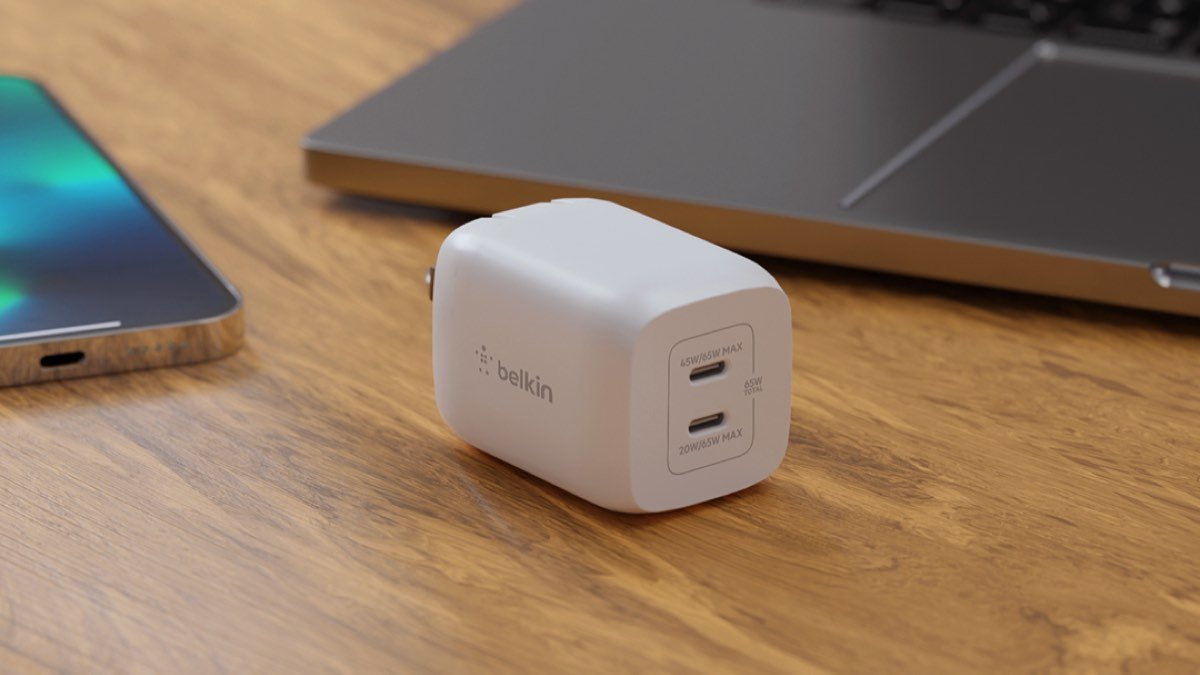Belkin's Boost Charge Pro charges an iPhone 13 to half in 20 minutes
Belkin's newest GaN charger , the BOOSTCHARGE PRO, offers USB-C Power Delivery 3.0 that can charge an iPhone 13 from zero to 50% in 20 minutes.

65W Belkin Boost Charge Pro
The product comes in two varieties. First, a 65W option will offer devices up to 65W of power using a single port, or up to 45W from port and 20W with a second port, in case charging multiple devices is needed.
The second variation, a 45W charger provides up to 45W of power from a single port. It can also provide up to 25W from one port and up to 20W from a second port when using both at once.
Belkin's charging result was achieved by using a USB-C to Lightning cable in the company's internal testing. Real-world results may vary depending on multiple factors, such as smartphone model, device age, and usage environment.
In addition to USB-C Power Delivery, which fast charges a device over a USB cable, the charger uses Programmable Power Supply (PPS). This technology provides the right amount of power to devices by adjusting the voltage and current in real-time, depending on a device's charging status.
This, combined with the gallium nitride (GaN) material in the charger, aims to reduce overheating during a charge, a common issue when using a fast charger. Belkin says the BOOSTCHARGE PRO is optimized for Apple and Samsung devices, as well as the Nintendo Switch.
THe 65W BOOSTCHARGE PRO variant is available for for $49.99, while the 45W BOOSTCHARGE PRO can be purchased for $39.99.
Read on AppleInsider

65W Belkin Boost Charge Pro
The product comes in two varieties. First, a 65W option will offer devices up to 65W of power using a single port, or up to 45W from port and 20W with a second port, in case charging multiple devices is needed.
The second variation, a 45W charger provides up to 45W of power from a single port. It can also provide up to 25W from one port and up to 20W from a second port when using both at once.
Belkin's charging result was achieved by using a USB-C to Lightning cable in the company's internal testing. Real-world results may vary depending on multiple factors, such as smartphone model, device age, and usage environment.
In addition to USB-C Power Delivery, which fast charges a device over a USB cable, the charger uses Programmable Power Supply (PPS). This technology provides the right amount of power to devices by adjusting the voltage and current in real-time, depending on a device's charging status.
This, combined with the gallium nitride (GaN) material in the charger, aims to reduce overheating during a charge, a common issue when using a fast charger. Belkin says the BOOSTCHARGE PRO is optimized for Apple and Samsung devices, as well as the Nintendo Switch.
THe 65W BOOSTCHARGE PRO variant is available for for $49.99, while the 45W BOOSTCHARGE PRO can be purchased for $39.99.
Read on AppleInsider

Comments
I have 5-6 of them collected over the years from various iPhones and iPad purchases. I have one in my travel kit; I just plug in my phone when I go to sleep since even a 5W charger will provide a full charge overnight.
No need to put necessary stress on the battery.
Fast charging support on the iPhone isn't new. When it debuted there were quite a few articles about the cons of fast charging.
At home I have an old 4-port USB-A charger that doesn't support fast charging for my iPhone, my iPods Pro, and a couple of other devices. In fact, this charger is a model that doesn't have higher amperage support for charging iPads.
I don't remember ever running out of battery on my iPhone. When I go to bed there's always some charge left whether I'm at home or traveling; when I wake up the battery is full.
iPhone battery life has increased over the years. Since I've never ran out of juice when I first started using them (iPhone 4S), there's little chance that I will run my iPhone dry today unless I drastically change my usage habits.
Yeah, I have a MagSafe puck for nighttime, a large 6-way multi charger in the kitchen (phones, tablets, anything USB), two 20W Apple USB-C bricks, a PD power bank, multiple chargers for my drones and RC planes, and two older USB power banks that I keep in the garage (strictly for my phone when out there working or goofing off). Then there is a third party MagSafe in the car, and anything I need at work. So unless the phone doesn't charge due to misplacement of the puck or just forgetting, I rarely run out of power.